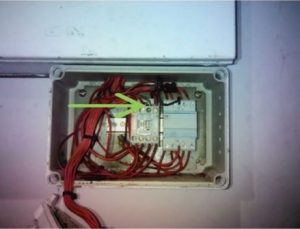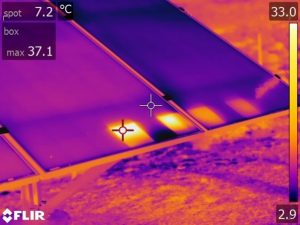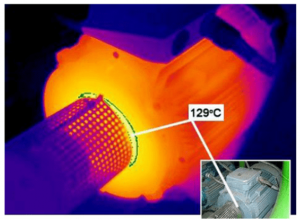Due to recent significant Fire Losses in the industry because of electrical fires all business should conduct Thermographic Scanning of switchboard & machinery as a matter of priority to ensure that a fire does not occur as a result of electrical faults.
It is recognised throughout the insurance and fire protection industries that electrical failure is one of the most common sources of fire.
Some of the benefits of thermographic scanning includes: Safety, Reduced outage costs, Improved and less expensive maintenance and Reduced operational costs. Thermographic scanning is a valuable resource in implementing preventative maintenance and maintaining electrical services to machinery. It can also reduce the risk an electrical fire.
Scanning should be performed on a regular basis (annually as a minimum) to allow trending results. Collection of data and interpretation requires specialist training and should only be conducted by competent personnel, preferably from a recognised thermal imaging company.

RISK.
Let’s understand the risk of equipment and components. All manufactured equipment of components FAIL. Preventative maintenance helps plant owners and managers to extend the life of the equipment and components. Strategic inspections of the equipment and components allows us to understand if and when these components may fail. Catastrophic failure especially in electrical equipment generally leads to hot spots and further on from that a fire, potential destroying the equipment, facility and creating am unsafe place for employees.
Thermographic Inspections carried out by a certified thermographic can help prevent these failures and reduce the risks.
Example Electrical Component
When electrical connections and components overheat, it can be a sign of impending failure. So maintenance professionals need a fast, reliable way to spot these problems early and begin working on repairs and preventive maintenance. Conducting electrical panel inspections using a thermal camera can reveal hidden hot spots and provide maintenance workers the opportunity to solve electrical issues before they create a serious and costly problem.
This Fault was probably one of the most satisfying finds the thermographer could have found, as this is a lighting contactor box underneath a main switch board in a large retail shop. The possibility of disaster was very real as the cable when found was sparking and if this caught fire it would have entered the main switchboard and mostly likely would have shorted out possibly taking the whole department store out. The Electrician was notified, and this bank of lighting was tuned off.
In Summary, it doesn’t matter how big or small the component the possible outcome will be the same if the fault wasn’t found in the first place or rectified in a timely manner, catastrophic failure would have occurred.
This example tells us that at a minimum, annual thermographic inspections should be carried out on electrical switchboards and panels.


Thermographic Inspection Solar Panels.
Like electrical components and equipment, solar panels also have the potential to fail if not maintain correctly.
Temperature changes can be an early indicator of equipment deterioration, non-uniform temperature profiles on products, or a hotspot area, thermal cameras are the best choice for plant managers. InfraRed thermal cameras provide a temperature value for every pixel in an image and clearly visualize the temperature differences of an inspected area. Upon exceeding a specific temperature threshold, a thermal camera will clearly identify a hot stop that is a concern.
It’s daunting to consider how to efficiently and accurately inspect a solar field. For asset owners, Thermographers, and drone service providers (DSPs) to meet the growing demand they must develop a understanding of thermography, flight operations, and other factors to take full advantage of the benefits of drone-based thermographic inspections. This allows the solar farm owners the chance to eliminate the risk of a failure in a panel, that has the potential to start a fire.
Aerial thermal imaging cameras make it easy to quickly inspect a large solar farm and pinpoint solar panel problems down to cell-level defects. They streamline the completion of a qualitative analysis by allowing the operator to quickly see heat differentials across a PV system and identify possible damage.
An example of the hot spot in a solar module below.


Mechanical Equipment and components.
Electric motors range in size, heavy-duty, ranging in size from sub-hp to 1,000-hp units to 5-hp or smaller. It’s important for us to detect overheating because hot windings deteriorate rapidly. In fact, every increase of 10°C on a motor’s windings above its design operating temperature cuts the insulation life by 50%, even if the overheating is only temporary.
We think it’s important to be able to collect the heat signatures from the whole population of motors. On a paper machine, a five-hp unit on a pump supplying a coating or additive can be just as critical as a 1,000-hp motor. A failed pump motor can ruin a batch of paper or shut down the machine.
A motor’s heat signature tells us much about its quality and condition. Today vibration analysis as well as thermography on our most critical motors is performed. If vibration analysis uncovers a problem, it’s likely that a thermal image will help pinpoint what’s wrong.
The motivation for establishing regular routes for motor inspections derived from using thermography on motors only on an “exceptional occurrence” basis. In other words, if someone notices that a motor seems hot, investigation to find a root cause is carried out. If vibration data suggests a bad bearing or imbalance, it can confirm the diagnosis by a thermographic IR camera.
The picture that saved the day
A fan pump is the device that supplies paper stock to the head box, the first piece of hardware in a paper machine. The motor driving our fan pump is large and was running warm. If the pump went down, the paper machine would be dead in the water.
The IR image indicated a motor housing temperature of 284°F, hot enough to fry an egg. The image also showed that the heat was coming from the windings. We needed to install a new motor and send the hot one to be repaired. We deemed the replacement mandatory, so this wasn’t a planned outage. I monitored the motor closely for about a week until the replacement arrived and we shut the machine down. The outcome was better than it might have been if we had waited for a scheduled shutdown. And it was clearly better than letting it run, destroying the motor with no replacement on hand.

Bob Bateman – Solutions Consultant – Thermoscan Inspection Services Pty Ltd

CAN YOU REALLY AFFORD TO SUFFER A MAJOR FIRE LOSS IN YOUR BUSINESS?
CONTACT THERMOSCAN ON 1300 132 517 AND MENTION CMIB FOR A 10% DISCOUNT – WWW.THERMOSCAN.COM.AU

